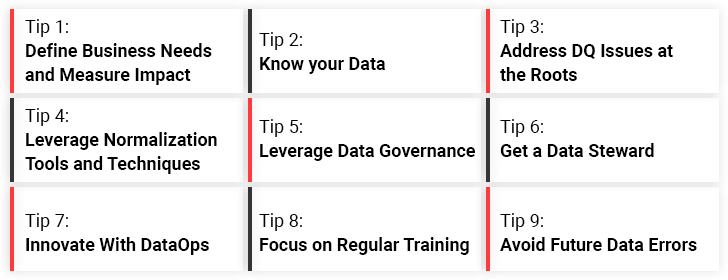 After all, high DQ ensures accurate outcomes of quantitative research, trusted reporting and analytics, greater success at AI initiatives, optimized operational processes, superior customer experience, and an even higher ROI. The best start to the DQ improvement process is by developing an organization-wide strategy that onboards everyone in the company to work collectively towards building a culture that fosters quality data.
After all, high DQ ensures accurate outcomes of quantitative research, trusted reporting and analytics, greater success at AI initiatives, optimized operational processes, superior customer experience, and an even higher ROI. The best start to the DQ improvement process is by developing an organization-wide strategy that onboards everyone in the company to work collectively towards building a culture that fosters quality data.
Tips to Create an Effective DQ Strategy
A data quality strategy is one that defines processes and systems to include DQ in all business activities to ascertain that only trusted data is used across the length and breadth of the organization. A result-oriented strategy apprehends business objectives, goals, processes, initiatives, and scope to enhance DQ along with integrity. Defining a DQ strategy enables businesses to identify, resolve, as well as prevent quality issues to build a stronger foundation of trusted data—and this is where B2B data cleansing services help. Listed here are some of the important tips to improve the quality of your data and get the best out of your data investments:
Tip 1: Define Business Needs and Measure Impact
Well-defined business needs to drive DQ improvement initiatives. Begin with prioritizing issues based on the company’s needs and how these might impact your organization in the long run. This will help establish a realistic goal as well as keep a check on the progress of quality improvement initiatives. Further, continuous reference to the organizational needs provides the context for refining your approach to quality data.Tip 2: Know your Data
Not all data is equal, meaning that not all pieces of information out there are relevant for your business; hence, the key here is to understand your data. This means that businesses not only need data that is ‘right’ for trusted users, but you also need the ‘right’ data to lay a stronger foundation. You should know your data correctly—what it contains, what is its source, how to extract value from it, etc., to determine if it is ‘right’ or relevant for your intended business use case. After all, data intelligence is the ability to understand the data correctly and leverage it in the right way. Correctly describing and connecting the dots (here data) throughout its journey is an ideal approach to enhance DQ.Tip 3: Address DQ Issues at the Roots
Data quality issues are often fixed temporarily so that the work isn’t impacted. For instance, what do data scientists do when they find incomplete entries in their selected datasets? They are most likely to fix those errors in their copy and proceed with their data processing and analysis. However, the original dataset still has those quality issues as the corrections do not reach the source, negatively impacting its subsequent use. As the adage goes, ‘prevention is better than cure,’ preventing dirty data from propagating is one way you can improve your DQ. Take another example where a healthcare staff faced difficulties contacting patients after their visits. To deal with this, they decided to address this issue at the source when they discovered that the contact numbers were wrong for various patients. These patients were then asked to verify their phone numbers while checking in. As a result, this eliminated the quality issue in datasets quickly.Tip 4: Leverage Normalization Tools and Techniques
Users sometimes make mistakes (incorrect spellings especially) while entering data in different forms. For example, they might write ‘treu’ for ‘true’ in a hurry and then forget about it. However, picking up such incorrect entries for analysis can seriously impact your DQ. Hence, leveraging a defined list of values whenever possible leaves no room for users to make such types of mistakes. Besides, an experienced data formatting company leverages the right-fit normalization tools and techniques to rectify inconsistencies and errors and enhance the dataset quality.Optimize Costs without Jeopardizing Growth via Data Cleansing Services





